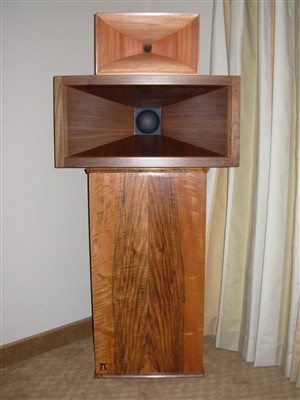

Posted by Wayne Parham [ 67.66.230.135 ] on June 17, 2005 at 02:41:07:
In Reply to: Just like the old 7Pi's? posted by Ian on June 17, 2005 at 02:02:05:
The basic seven π cabinet has been unchanged since inception in the 1970's. It's a very simple design, with its main feature being that the woofer radiates from the apex of the room's corner. The corner is used as a large CD horn that provides 9dB DI all by itself, and no passageways or labyrinthine cabinetry is required. That makes the cabinet easy to build, and it isn't prone to panel vibrations. It's easy to brace and there aren't a lot of complex pieces that might develop buzzes or panel resonances.
The best results are generally from cabinets having slightly overdamped ported alignments, but some rooms sound good with loudspeaker alignments having less damping. Very tightly sealed rooms might sound good using critically damped sealed alignments, but most framed drywall homes are somewhat lossy, and I prefer an overdamped vented alignment. But the point is that the bass bin design hasn't changed at all since the seventies. I like it very much, because it offers a lot from a very simple package.

The woofers used and the midrange and tweeter configurations have gone through several incremental changes. The first models used various Eminence and JBL Pro woofers, much like are still used today. My favorite early model had a JBL 2205 woofer and used JBL 2105 mids. The idea was to use the woofer up to the point where the walls transitioned from launch boundaries to reflectors, and crossover at that point. This also limited the number of standing wave modes that would be present in the cabinet interior.
I found that reflected midrange gave an ambience that sounded good too, so I experimented with putting midrange drivers in the rear in some models, and even ran the system as a two-way for a while. The current model uses a 90x40 midhorn that crosses over from the woofer before the walls act as reflectors, so there is very little reflected enegry. It sounds very natural and large.
What I've found is that each of these models shared a common trait of creating a very uniform reverberent field. This is a result of using sound sources that are all coming from the room's corner apex, and confined by the walls. None of the sound sources becomes more narrow than 90º except at the very highest frequencies, so the tonal balance throughout the room is good.
The main difference between versions, beyond the quality and tonal differences in the drivers themselves, is that some models generated more early reflections in the midrange. This creates a complex field that tends to give a sense of spaciousness. Those creating less early reflections sound a little more intimate, more like a close mic'ed recording. But in each case, the tonal balance is uniform throughout the room, and the basic character of the various models of π cornerhorn loudspeakers is similar in many respects.
[ PiSpeakers Forum ] [ Help ]